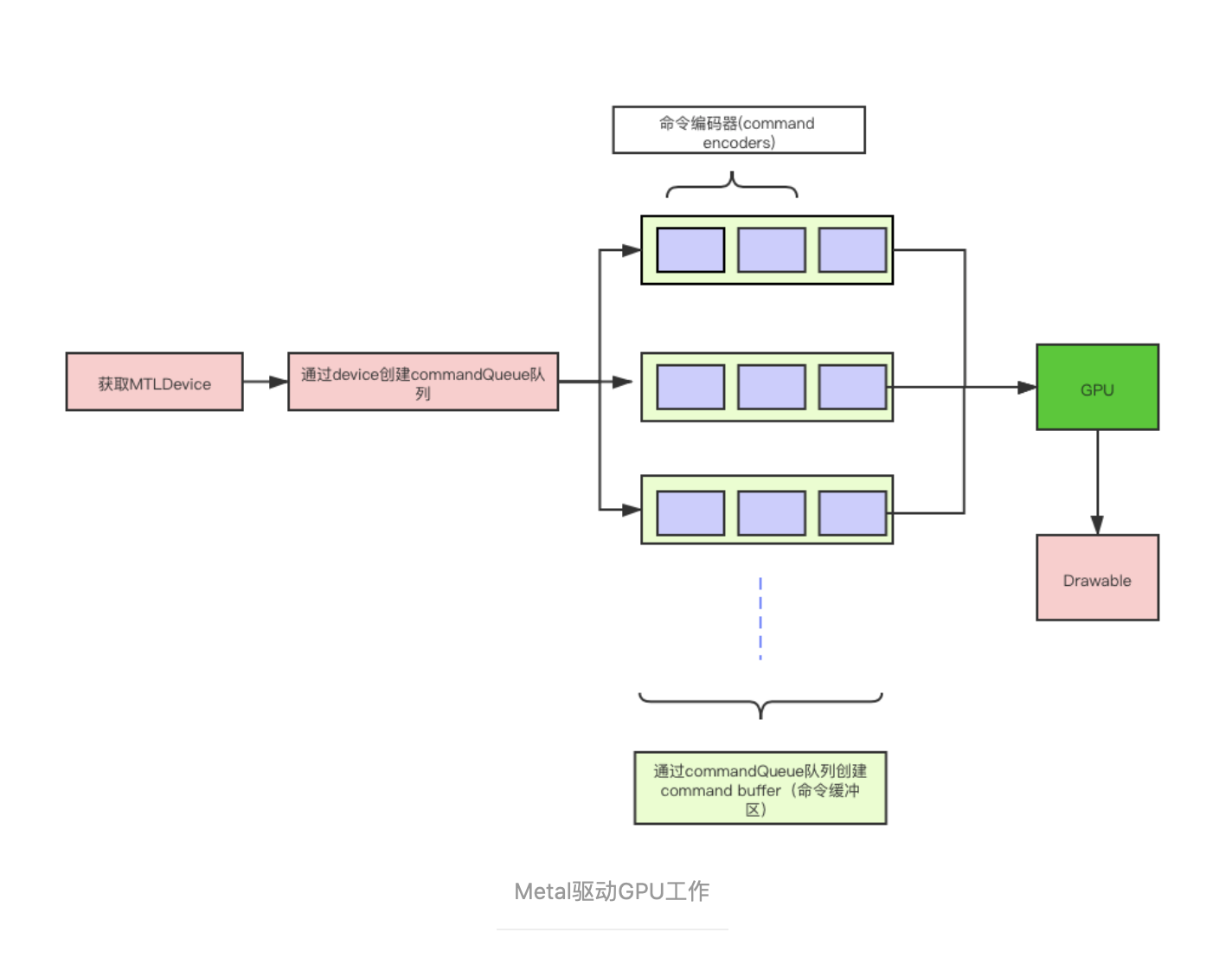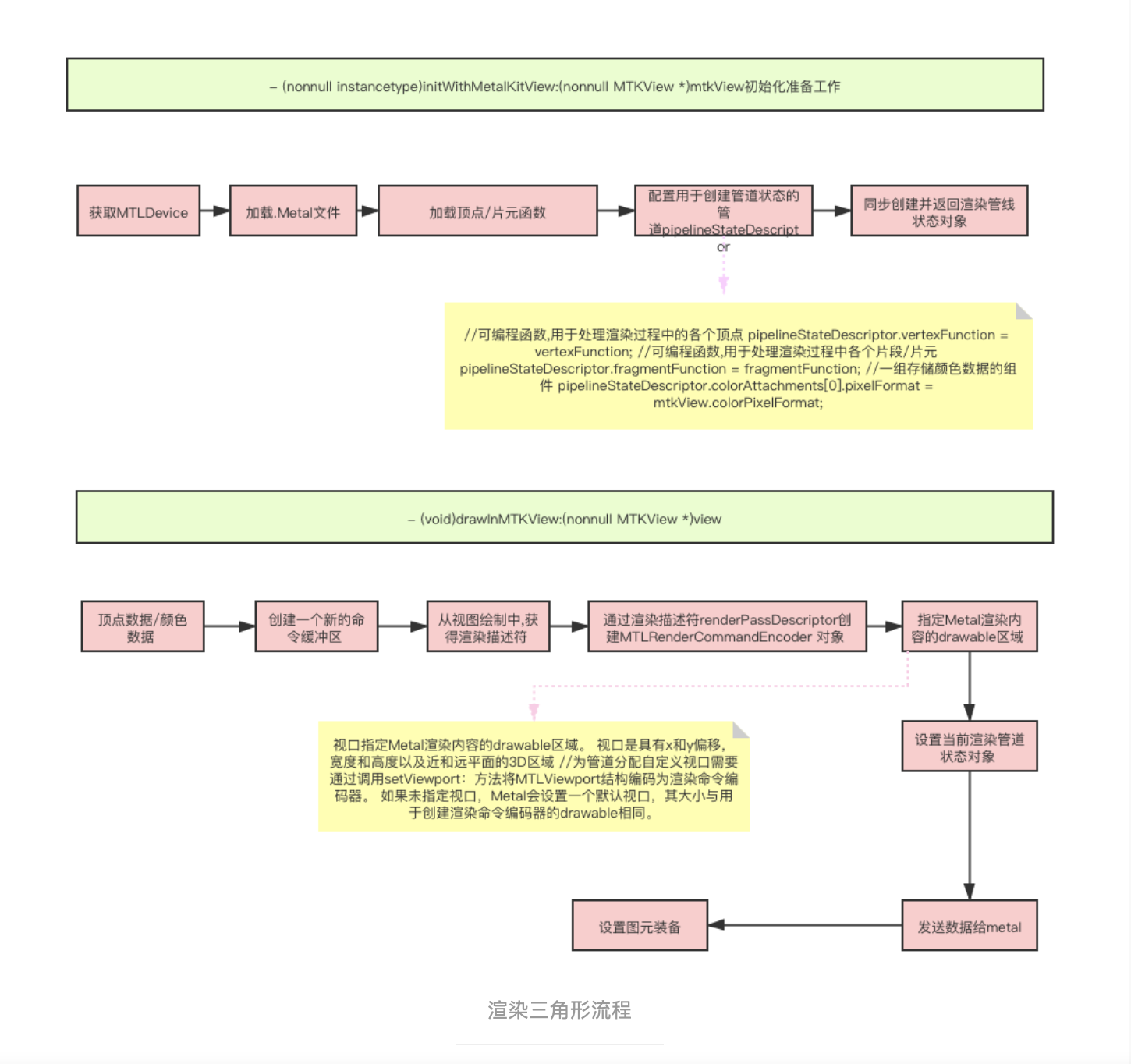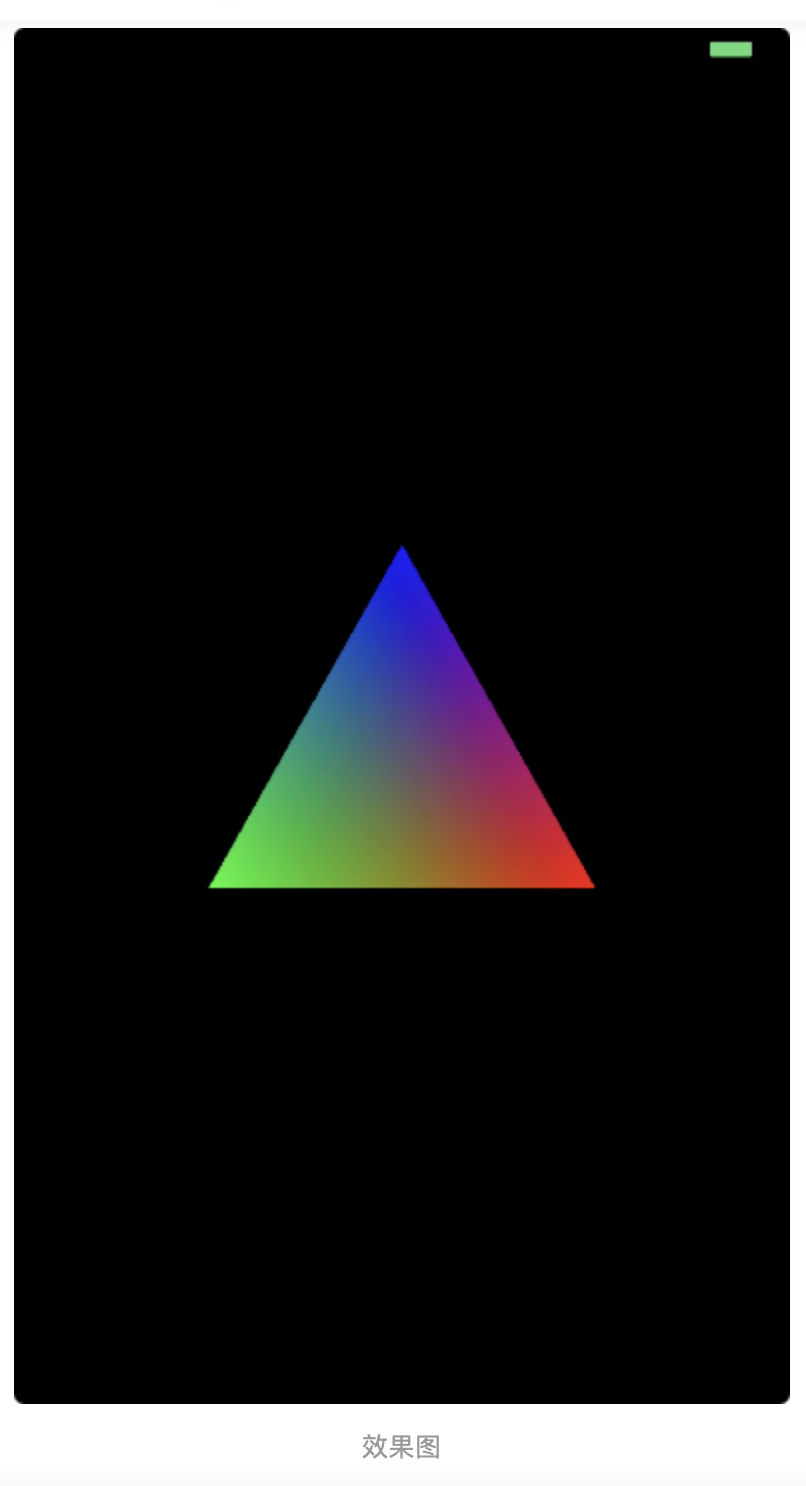iOS - Metal的认识
一.Metal 简介
在 WWDC 2014 上,Apple为游戏开发者推出了新的平台技术 Metal,该技术能够为 3D 图像提高 10 倍的渲染性能,并支持大家熟悉的游戏引擎及公司。
Metal 是一种低层次的渲染应用程序编程接口,提供了软件所需的最低层,保证软件可以运行在不同的图形芯片上。Metal 提升了 A7 与 A8 处理器效能,让其性能完全发挥。
Metal,充分利用GPU的运算能力,在现阶段,AVFoundation ⼈脸识别/.... 等大量需要显示计算的时候,苹果采用了硬件加速器驱动GPU工作,在音视频方面,⾳频编码/解码 / 视频编码/解码 ->压缩任务 ->都与硬件加速器分不开,苹果提供的Metal,能发挥GPU/CPu的最大性能,并且管理我们的资源。
二.Metal的渲染流程
Metal的渲染流程借鉴了OpenGLES的流程,它通过控制顶点着色器/片元着色器(Metal里面叫顶点函数/片元函数),交给帧缓冲区,最后显示到屏幕上

值得注意的是,在OpenGlES中,图元装配有9中,在Metal中,图元装配只有五种,他们分别是:
MTLPrimitiveTypePoint = 0, 点
MTLPrimitiveTypeLine = 1, 线段
MTLPrimitiveTypeLineStrip = 2, 线环
MTLPrimitiveTypeTriangle = 3, 三角形
MTLPrimitiveTypeTriangleStrip = 4, 三角型扇
三.Metal的初级准备工作
3.1Metal的注意事项
在讲Metal的初级使用之前,我们先来看看苹果爸爸给我们的建议,首先,苹果建议我们Separate Your Rendering Loop,即分离我们渲染,Metal给我们提供了一个View,叫MTKView,它继承自UiView,它主要的渲染是通过MTKViewDelegate协议回调实现,两个重要的协议方法是:
1)当MTKView视图发生大小改变时调用
/*!
@method mtkView:drawableSizeWillChange:
@abstract Called whenever the drawableSize of the view will change
@discussion Delegate can recompute view and projection matricies or regenerate any buffers to be compatible with the new view size or resolution
@paramviewMTKView which called this method
@paramsizeNew drawable size in pixels
*/
- (void)mtkView:(nonnull MTKView *)view drawableSizeWillChange:(CGSize)size;
2)每当视图需要渲染时调用
/*!
@method drawInMTKView:
@abstract Called on the delegate when it is asked to render into the view
@discussion Called on the delegate when it is asked to render into the view
*/
- (void)drawInMTKView:(nonnullMTKView*)view;
3.2 Metal是如何驱动GPU工作的?

相关对应代码:在ViewController中,我们把当前的View变成MTKView,当然你也可以用self.view添加一个子视图View,CCRenderer是自定义的一个类,主要是分离MTview的渲染,
_view.device = MTLCreateSystemDefaultDevice();一个MTLDevice 对象就代表这着一个GPU,通常我们可以调用方法MTLCreateSystemDefaultDevice()来获取代表默认的GPU单个对象.
在CCRenderer中的初始化方法中- (id)initWithMetalKitView:(MTKView *)mtkView我们拿到device,创建newCommandQueue队列:
_commandQueue = [_device newCommandQueue];
所有应用程序需要与GPU交互的第一个对象是一个对象->MTLCommandQueue. 你使用MTLCommandQueue 去创建对象,并且加入MTLCommandBuffer 对象中.确保它们能够按照正确顺序发送到GPU.对于每一帧,一个新的MTLCommandBuffer 对象创建并且填满了由GPU执行的命令.
在CCRenderer中,我们实现了MTKView的协议代理方法,在- (void)drawInMTKView:(nonnullMTKView*)view中,我们通过创建好的队列再创建命令缓冲区并且加入到MTCommandBuffer对象中去:
id<MTLCommandBuffer> commandBuffer = [_commandQueue commandBuffer];
值得注意的是,在创建好命令缓冲区后,Metal提出了一个概念叫渲染描述符:(个人理解这个渲染描述符是给每个命令打上一个标记,GPU在工作的时候通过这个渲染描述符取出相应的命令,如果说的不对,请大神指点)从视图绘制中,获得渲染描述符:
MTLRenderPassDescriptor *renderPassDescriptor = view.currentRenderPassDescriptor;
通过渲染描述符renderPassDescriptor创建MTLRenderCommandEncoder
id<MTLRenderCommandEncoder> renderEncoder = [commandBuffer renderCommandEncoderWithDescriptor:renderPassDescriptor];
最后 [renderEncoderendEncoding];
当编码器结束之后,命令缓存区就会接受到2个命令.
1) present
2) commit
因为GPU是不会直接绘制到屏幕上,因此你不给出去指令.是不会有任何内容渲染到屏幕上.
[commandBuffer presentDrawable:view.currentDrawable];
[commandBuffercommit];
至此,Metal的准备工作已经完成
四.用Metal渲染一个简单的三角形
在做好上面的准备的准备工作后:

//初始化MTKView
- (nonnull instancetype)initWithMetalKitView:(nonnull MTKView *)mtkView
{
self= [superinit];
if(self)
{
NSError*error =NULL;
//1.获取GPU 设备
_device= mtkView.device;
//2.在项目中加载所有的(.metal)着色器文件
// 从bundle中获取.metal文件
id defaultLibrary = [_devicenewDefaultLibrary];
//从库中加载顶点函数
id vertexFunction = [defaultLibrarynewFunctionWithName:@"vertexShader"];
//从库中加载片元函数
id fragmentFunction = [defaultLibrarynewFunctionWithName:@"fragmentShader"];
//3.配置用于创建管道状态的管道
MTLRenderPipelineDescriptor *pipelineStateDescriptor = [[MTLRenderPipelineDescriptor alloc] init];
//管道名称
pipelineStateDescriptor.label=@"Simple Pipeline";
//可编程函数,用于处理渲染过程中的各个顶点
pipelineStateDescriptor.vertexFunction= vertexFunction;
//可编程函数,用于处理渲染过程中各个片段/片元
pipelineStateDescriptor.fragmentFunction= fragmentFunction;
//一组存储颜色数据的组件
pipelineStateDescriptor.colorAttachments[0].pixelFormat= mtkView.colorPixelFormat;
//4.同步创建并返回渲染管线状态对象
_pipelineState= [_devicenewRenderPipelineStateWithDescriptor:pipelineStateDescriptorerror:&error];
//判断是否返回了管线状态对象
if (!_pipelineState)
{
//如果我们没有正确设置管道描述符,则管道状态创建可能失败
NSLog(@"Failed to created pipeline state, error %@", error);
returnnil;
}
//5.创建命令队列
_commandQueue = [_device newCommandQueue];
}
return self;
}
//每当视图需要渲染帧时调用
- (void)drawInMTKView:(nonnullMTKView*)view
{
//1. 顶点数据/颜色数据
staticconstCCVertextriangleVertices[] =
{
//顶点, RGBA 颜色值
{ { 0.5, -0.25,0.0,1.0}, {1,0,0,1} },
{ { -0.5, -0.25,0.0,1.0}, {0,1,0,1} },
{ { -0.0f,0.25,0.0,1.0}, {0,0,1,1} },
};
//2.为当前渲染的每个渲染传递创建一个新的命令缓冲区
id<MTLCommandBuffer> commandBuffer = [_commandQueue commandBuffer];
//指定缓存区名称
commandBuffer.label=@"MyCommand";
//3.
// MTLRenderPassDescriptor:一组渲染目标,用作渲染通道生成的像素的输出目标。
MTLRenderPassDescriptor *renderPassDescriptor = view.currentRenderPassDescriptor;
//判断渲染目标是否为空
if(renderPassDescriptor !=nil)
{
//4.创建渲染命令编码器,这样我们才可以渲染到something
id renderEncoder =[commandBufferrenderCommandEncoderWithDescriptor:renderPassDescriptor];
//渲染器名称
renderEncoder.label=@"MyRenderEncoder";
//5.设置我们绘制的可绘制区域
/*
typedef struct {
double originX, originY, width, height, znear, zfar;
} MTLViewport;
*/
//视口指定Metal渲染内容的drawable区域。 视口是具有x和y偏移,宽度和高度以及近和远平面的3D区域
//为管道分配自定义视口需要通过调用setViewport:方法将MTLViewport结构编码为渲染命令编码器。 如果未指定视口,Metal会设置一个默认视口,其大小与用于创建渲染命令编码器的drawable相同。
MTLViewportviewPort = {
0.0,0.0,_viewportSize.x,_viewportSize.y,-1.0,1.0
};
[renderEncodersetViewport:viewPort];
//[renderEncoder setViewport:(MTLViewport){0.0, 0.0, _viewportSize.x, _viewportSize.y, -1.0, 1.0 }];
//6.设置当前渲染管道状态对象
[renderEncodersetRenderPipelineState:_pipelineState];
//7.从应用程序OC 代码 中发送数据给Metal 顶点着色器 函数
//顶点数据+颜色数据
// 1) 指向要传递给着色器的内存的指针
// 2) 我们想要传递的数据的内存大小
// 3)一个整数索引,它对应于我们的“vertexShader”函数中的缓冲区属性限定符的索引。
[renderEncodersetVertexBytes:triangleVertices
length:sizeof(triangleVertices)
atIndex:CCVertexInputIndexVertices];
//viewPortSize 数据
//1) 发送到顶点着色函数中,视图大小
//2) 视图大小内存空间大小
//3) 对应的索引
[renderEncodersetVertexBytes:&_viewportSize
length:sizeof(_viewportSize)
atIndex:CCVertexInputIndexViewportSize];
//8.画出三角形的3个顶点
// @method drawPrimitives:vertexStart:vertexCount:
//@brief 在不使用索引列表的情况下,绘制图元
//@param 绘制图形组装的基元类型
//@param 从哪个位置数据开始绘制,一般为0
//@param 每个图元的顶点个数,绘制的图型顶点数量
/*
MTLPrimitiveTypePoint = 0, 点
MTLPrimitiveTypeLine = 1, 线段
MTLPrimitiveTypeLineStrip = 2, 线环
MTLPrimitiveTypeTriangle = 3, 三角形
MTLPrimitiveTypeTriangleStrip = 4, 三角型扇
*/
[renderEncoderdrawPrimitives:MTLPrimitiveTypeTriangle
vertexStart:0
vertexCount:3];
//9.表示已该编码器生成的命令都已完成,并且从NTLCommandBuffer中分离
[renderEncoderendEncoding];
//10.一旦框架缓冲区完成,使用当前可绘制的进度表
[commandBufferpresentDrawable:view.currentDrawable];
}
//11.最后,在这里完成渲染并将命令缓冲区推送到GPU
[commandBuffercommit];
}

Metal文件:(语法下篇介绍)
#include
//使用命名空间 Metal
using namespace metal;
// 导入Metal shader 代码和执行Metal API命令的C代码之间共享的头
#import "CCShaderTypes.h"
// 顶点着色器输出和片段着色器输入
//结构体
typedef struct
{
//处理空间的顶点信息
float4clipSpacePosition [[position]];
//颜色
float4color;
} RasterizerData;
//顶点着色函数
vertex RasterizerData
vertexShader(uintvertexID [[vertex_id]],
constantCCVertex*vertices [[buffer(CCVertexInputIndexVertices)]],
constantvector_uint2*viewportSizePointer [[buffer(CCVertexInputIndexViewportSize)]])
{
/*
处理顶点数据:
1) 执行坐标系转换,将生成的顶点剪辑空间写入到返回值中.
2) 将顶点颜色值传递给返回值
*/
//定义out
RasterizerDataout;
// //初始化输出剪辑空间位置
// out.clipSpacePosition = vector_float4(0.0, 0.0, 0.0, 1.0);
//
// // 索引到我们的数组位置以获得当前顶点
// // 我们的位置是在像素维度中指定的.
// float2 pixelSpacePosition = vertices[vertexID].position.xy;
//
// //将vierportSizePointer 从verctor_uint2 转换为vector_float2 类型
// vector_float2 viewportSize = vector_float2(*viewportSizePointer);
//
// //每个顶点着色器的输出位置在剪辑空间中(也称为归一化设备坐标空间,NDC),剪辑空间中的(-1,-1)表示视口的左下角,而(1,1)表示视口的右上角.
// //计算和写入 XY值到我们的剪辑空间的位置.为了从像素空间中的位置转换到剪辑空间的位置,我们将像素坐标除以视口的大小的一半.
// out.clipSpacePosition.xy = pixelSpacePosition / (viewportSize / 2.0);
out.clipSpacePosition= vertices[vertexID].position;
//把我们输入的颜色直接赋值给输出颜色. 这个值将于构成三角形的顶点的其他颜色值插值,从而为我们片段着色器中的每个片段生成颜色值.
out.color= vertices[vertexID].color;
//完成! 将结构体传递到管道中下一个阶段:
returnout;
}
//当顶点函数执行3次,三角形的每个顶点执行一次后,则执行管道中的下一个阶段.栅格化/光栅化.
// 片元函数
//[[stage_in]],片元着色函数使用的单个片元输入数据是由顶点着色函数输出.然后经过光栅化生成的.单个片元输入函数数据可以使用"[[stage_in]]"属性修饰符.
//一个顶点着色函数可以读取单个顶点的输入数据,这些输入数据存储于参数传递的缓存中,使用顶点和实例ID在这些缓存中寻址.读取到单个顶点的数据.另外,单个顶点输入数据也可以通过使用"[[stage_in]]"属性修饰符的产生传递给顶点着色函数.
//被stage_in 修饰的结构体的成员不能是如下这些.Packed vectors 紧密填充类型向量,matrices 矩阵,structs 结构体,references or pointers to type 某类型的引用或指针. arrays,vectors,matrices 标量,向量,矩阵数组.
fragmentfloat4fragmentShader(RasterizerDatain [[stage_in]])
{
//返回输入的片元颜色
returnin.color;
}
用于OC和Metal桥接的文件:
/*
介绍:
头文件包含了 Metal shaders 与C/OBJC 源之间共享的类型和枚举常数
*/
#ifndef CCShaderTypes_h
#define CCShaderTypes_h
// 缓存区索引值 共享与 shader 和 C 代码 为了确保Metal Shader缓存区索引能够匹配 Metal API Buffer 设置的集合调用
typedef enum CCVertexInputIndex
{
//顶点
CCVertexInputIndexVertices =0,
//视图大小
CCVertexInputIndexViewportSize =1,
} CCVertexInputIndex;
//结构体: 顶点/颜色值
typedef struct
{
// 像素空间的位置
// 像素中心点(100,100)
vector_float4 position;
// RGBA颜色
vector_float4 color;
} CCVertex;
#endif
链接:https://www.jianshu.com/p/a6f3c90d6ba5
